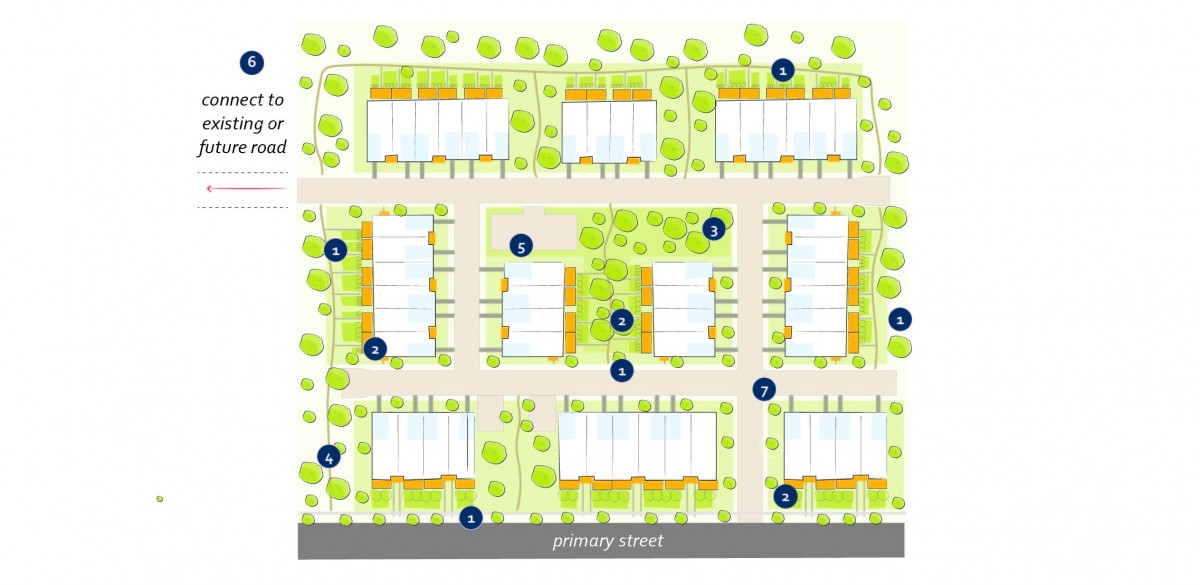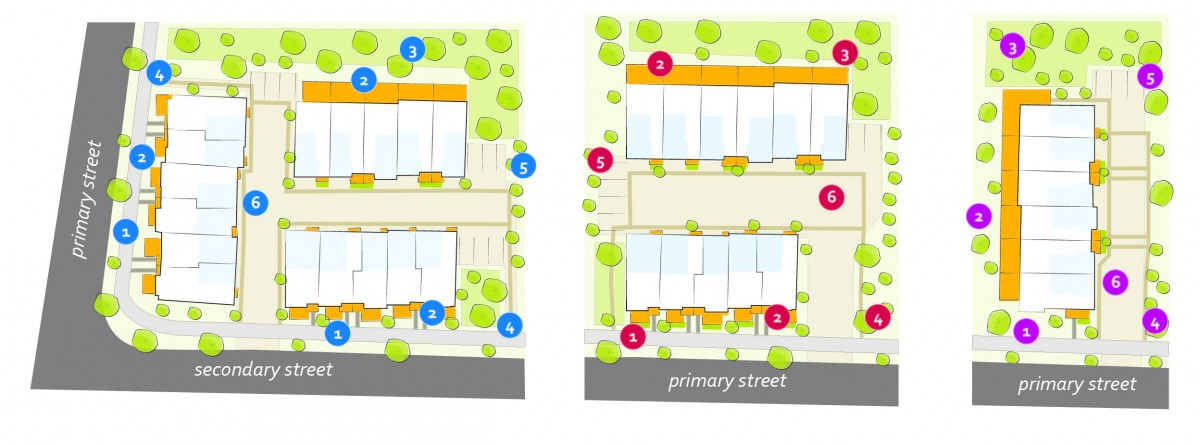2040 Official Community Plan - Form & Character
Townhouses and Infill

3.0 Townhouses
Overview |
|
General Characteristics |
|
In order to achieve the design goals of the City, all townhouse projects must:
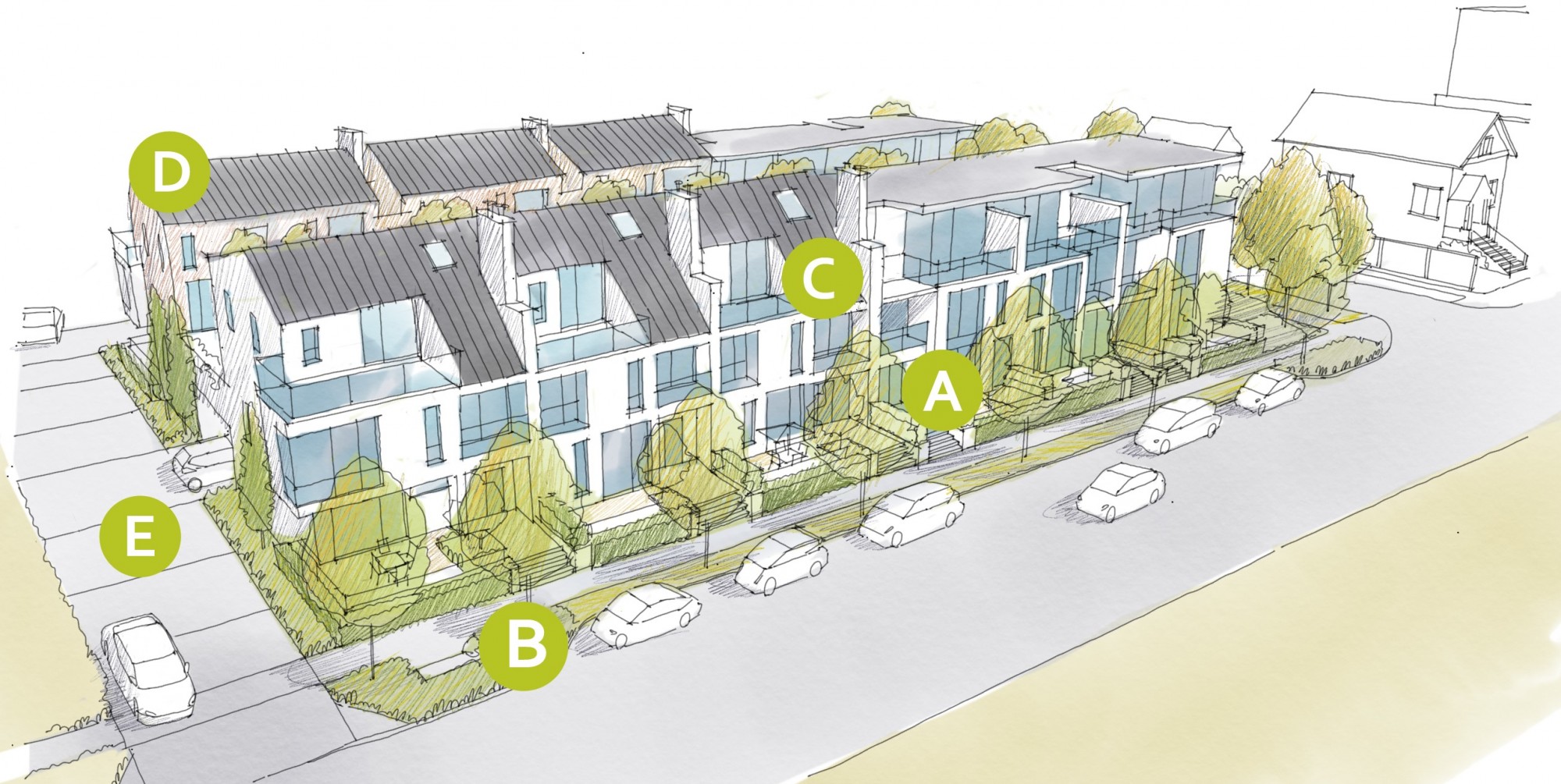
| A | 3.0.1 a – Orient building entries, windows , patios, and balconies to face the fronting street, with the primary entry clearly visible and directly accessible from the sidewalk (see 3.1.1). |
| B | 3.0.1 b – Provide usable outdoor amenity spaces and generous and well-designed landscaped areas that offer privacy, screening, and attractive interfaces with streets and open spaces (see 3.1.4). |
| C | 3.0.1 c – Use building articulation, scaling, and setbacks to define individual units or intervals and to contribute to a consistent frontage pattern, pedestrian scale and rhythm along the fronting street (see 3.1.2 and 3.1.6). |
| D | 3.0.1 d – Locate and design buildings to maximize access to sunlight, increase privacy, and reinforce neighbourhood character (see 3.1.4 and 3.1.6). |
| E | 3.0.1 e – Provide access to parking from a secondary street or lane, wherever possible (see 3.1.5). |
Design intent: To site and design buildings to positively frame and activate streets and public open spaces, while providing a clearly-defined public-private transition zone.
Guidelines
In addition to the strategies outlined in the General Residential and Mixed Use Guidelines:
A clearly visible front door directly accessible from a public street or publicly accessible pathway via a walkway, porch and/or stoop (See Figure 17);
- Design primary unit entrances to provide:
- A clearly visible front door directly accessible from a public street or publicly accessible pathway via a walkway, porch and/or stoop (See Figure 17);
- Architectural entrance features such as stoops, porches, shared landings, patios, recessed entries, and canopies;
- A sense of transition from the public to private realm by utilizing strategies such as changes in grade, decorative railings, and planters; and
- Punctuation, articulation and rhythm along the street.
- A maximum 1.2m height (e.g., 5-6 steps) is desired for front entryways or stoops. Exceptions can be made in cases where the water table requires this to be higher.
- In the case of shared landings that provide access to multiple units, avoid having more than two doors in a row facing outward.
- For buildings oriented perpendicularly to the street (e.g., ‘shotgun’ townhomes), ensure that the end unit facing the street is a custom street-oriented unit with primary entry directly accessible from the fronting street and primary living space at grade (See Figure 18).
- For large townhouse projects (e.g., master planned communities with internal circulation pattern), guidelines 3.1.1 a-d apply for units facing strata roads as well as those units fronting onto public streets.
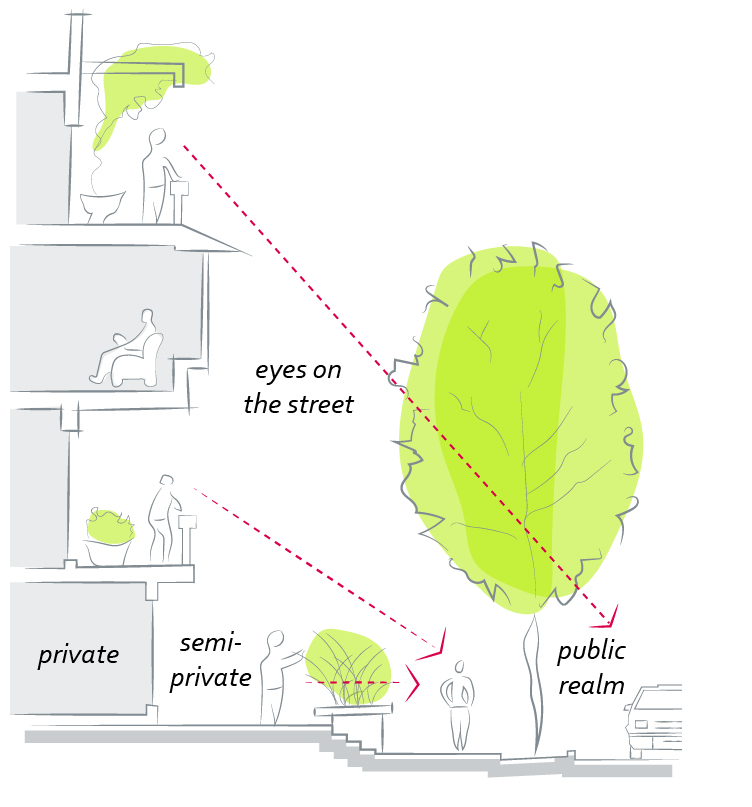 |
| Figure 17: Provide clear front entries, patios and stoops to ensure eyes on the street and provide opportunities for surveillance (3.1.1 a). |
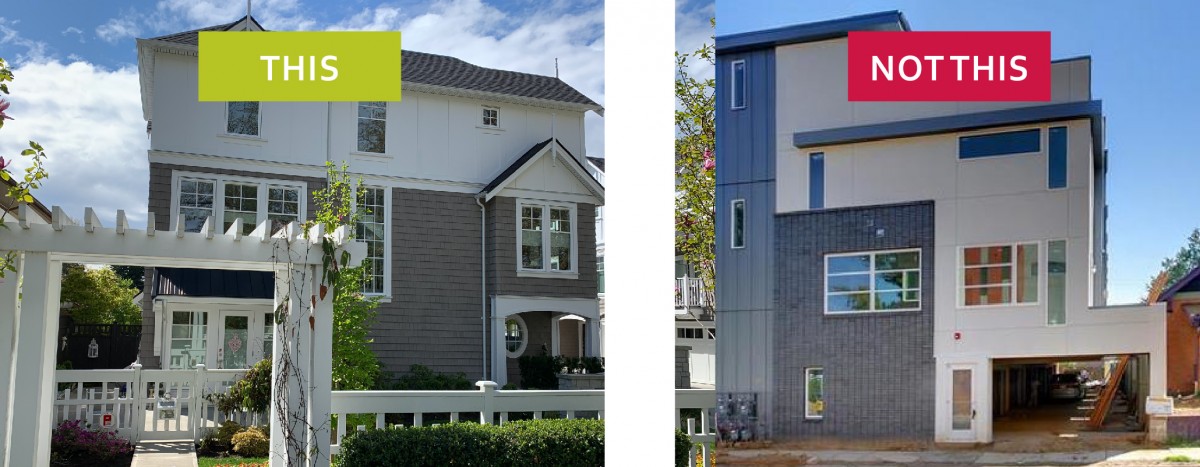 |
| Figure 18: In ‘shotgun’ townhouse projects, ensure that the end unit facing the street is a true street-oriented unit (3.1.1. d) . |
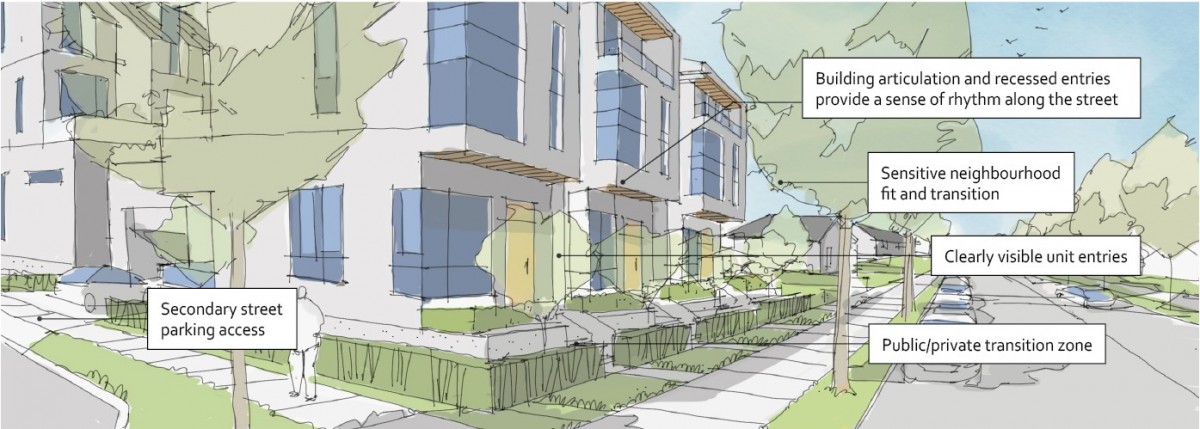 |
Design intent: To ensure buildings contribute positively to the neighbourhood context and provide a sensitive transition in scale to existing and future buildings, parks, and open spaces.
Guidelines
In addition to the strategies outlined in the General Residential and Mixed Use Guidelines:
- Wherever possible, reflect the positive attributes of adjacent housing while integrating new higher density forms of housing as envisioned in the OCP.
- Scale and site buildings to establish consistent rhythm along the street by, for example, articulating individual units through integration of recessed entries, balconies, a change in materials and slight projection/recess in the facade.
- Limit the number of connected townhouse units to a maximum of 6 units before splitting into multiple buildings.
- In larger townhouse developments (e.g., master planned communities with internal circulation pattern), integrate a large proportion of 4 unit townhouse buildings to create a finer grain of development and limit visual impacts.
Design intent: To site buildings to respond sensitively to topography and environmental features; to enhance privacy, liveability, safety and accessibility; and to increase connectivity to the surrounding open space network.
Guidelines
In addition to the strategies outlined in the General Residential and Mixed Use Guidelines:
- Gated or walled communities are not supported.
- For large townhouse projects, consider including communal amenity buildings.
Connectivity
- Provide pedestrian pathways on site to connect:
- Main building entrances to public sidewalks and open spaces;
- Visitor parking areas to building entrances; and
- From the site to adjacent pedestrian/trail/cycling networks (where applicable).
- When pedestrian connections are provided on site, frame them with an active edge – with entrances and windows facing the path or lane (See Figure 19 & 20).
- For large townhouse projects (e.g., master planned communities with internal circulation pattern):
- Design the internal circulation pattern to be integrated with and connected to the existing and planned public street network.
Facing Distances and Setbacks
- Design the internal circulation pattern to be integrated with and connected to the existing and planned public street network.
- Locate and design buildings to maintain access to sunlight, and reduce overlook between buildings and neighbouring properties.
- Separate facing buildings on site a minimum of 10-12m to provide ample spatial separation and access to sunlight.
- Limit building element projections, such as balconies, into setback areas, streets, and amenity areas to protect solar access.
- Front yard setbacks on internal roads should respond to the height of townhouses, with taller townhouses (e.g., 3 storeys) having greater setbacks to improve liveability and solar access.
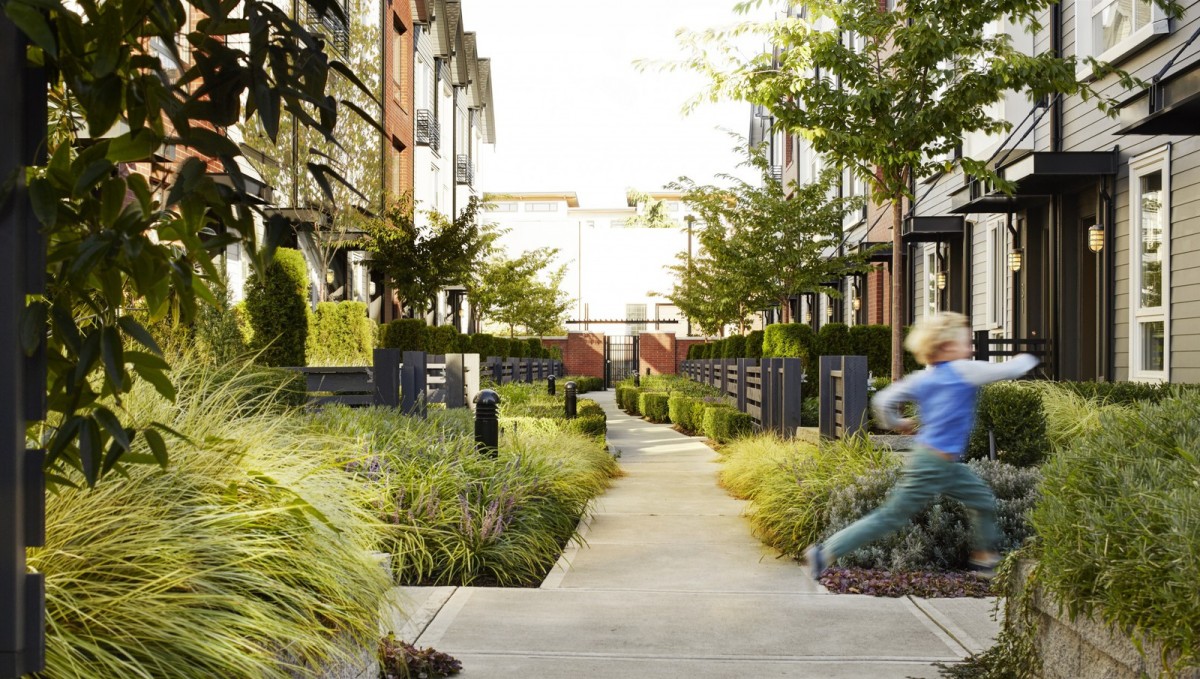 |
| Figure 19: An example of townhouses with clearly visible front doors fronting onto a publicly-accessible pedestrian pathway ( 3.1.3 d). |
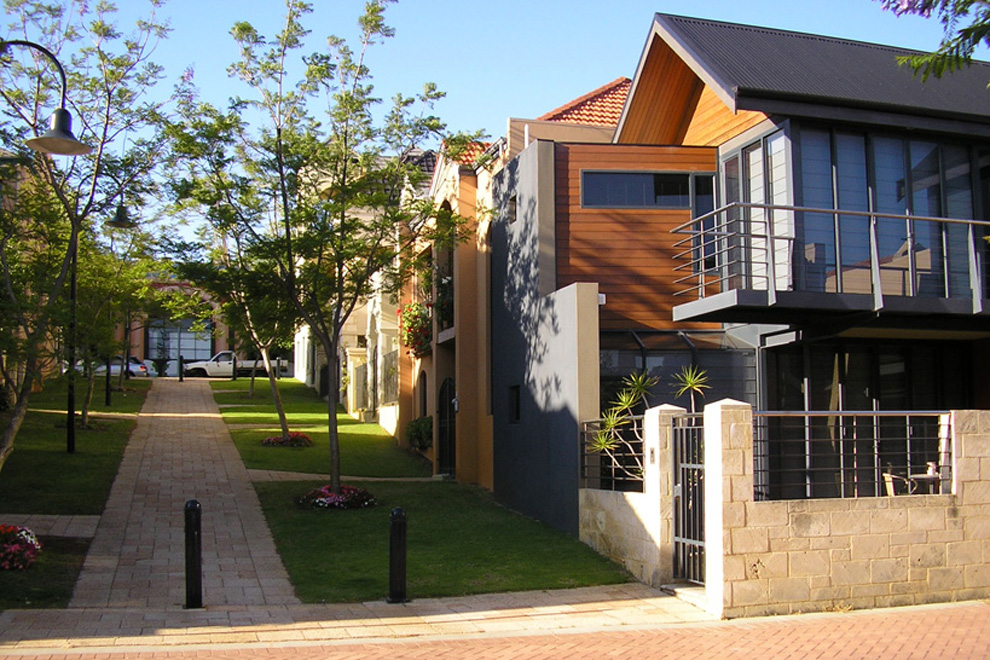 |
| Figure 20: Example of a mid-block connection through a townhouse site, with building entries facing onto the path ( 3.1.3 d). |
Design intent: To design landscapes and open spaces that provide integrated, flexible, and accessible open space.
Guidelines
In addition to the strategies outlined in the General Residential and Mixed Use Guidelines:
- Design all units to have easy access to useable private or semi-private outdoor amenity space (See Figure 20 & 21).
- Design front yards to include a path from the fronting street to the primary entry, landscaping, and semi-private outdoor amenity space.
- Avoid a ‘rear yard’ condition with undeveloped frontages along streets and open spaces.
- Design private outdoor amenity spaces to:
- Have access to sunlight;
- Have railing and/or fencing to help increase privacy; and
- Have landscaped areas to soften the interface with the street or open spaces.
- Design front patios to:
- Provide an entrance to the unit; and
- Be raised a minimum of 0.6m and a maximum of 1.2m to create a semi-private transition zone.
- Design rooftop patios to (See Figure 22):
- Have parapets with railings;
- Minimize direct sight lines into nearby units; and
- Have access away from primary facades.
- Design balconies to be inset or partially inset to offer privacy and shelter, reduce building bulk, and minimize shadowing.
- Consider using balcony strategies to reduce the significant potential for heat loss through thermal bridge connections which could impact energy performance (see 2.2.1).
- Provide a minimum of 10% of the total site area to common outdoor amenity spaces that:
- Incorporate landscaping, seating, play space, and other elements that encourage gathering or recreation; and
- Avoid isolated, irregularly shaped areas or areas impacted by parking, mechanical equipment, or servicing areas.
- For large townhouse projects, provide generous shared outdoor amenity spaces integrating play spaces, gardening, storm water and other ecological features, pedestrian circulation, communal amenity buildings, and other communal uses.
- Design internal roadways to serve as additional shared space (e.g., vehicle access, pedestrian access, open space) using strategies such as:
- High-quality pavement materials (e.g., permeable pavers); and
- Providing useable spaces for sitting, gathering and playing.
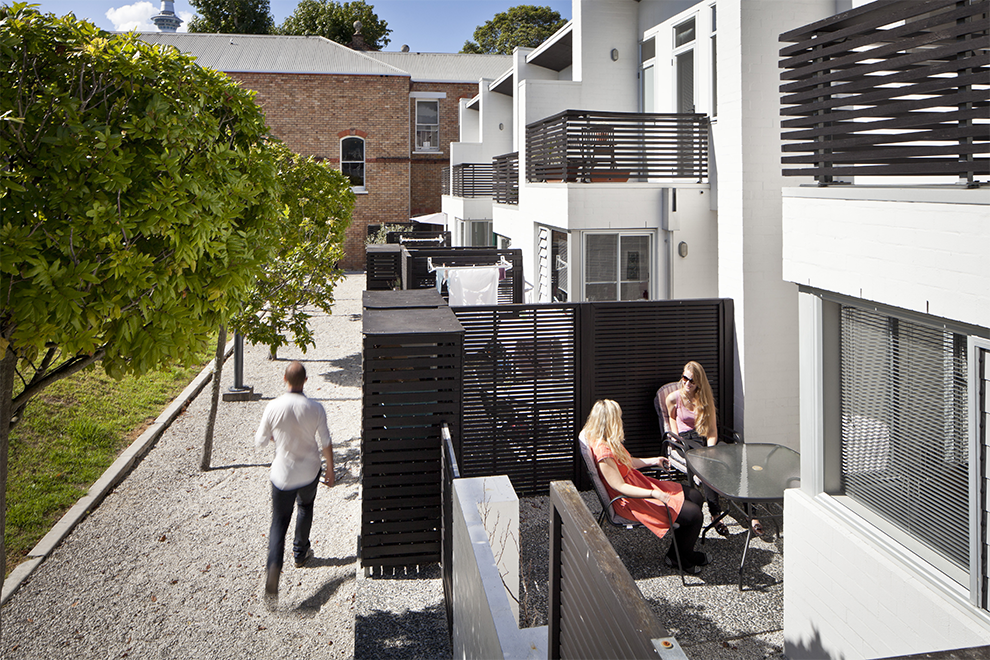 |
| Figure 21: All units should have easy access to useable private or semi-private outdoor amenity space (3.1.4 a). |
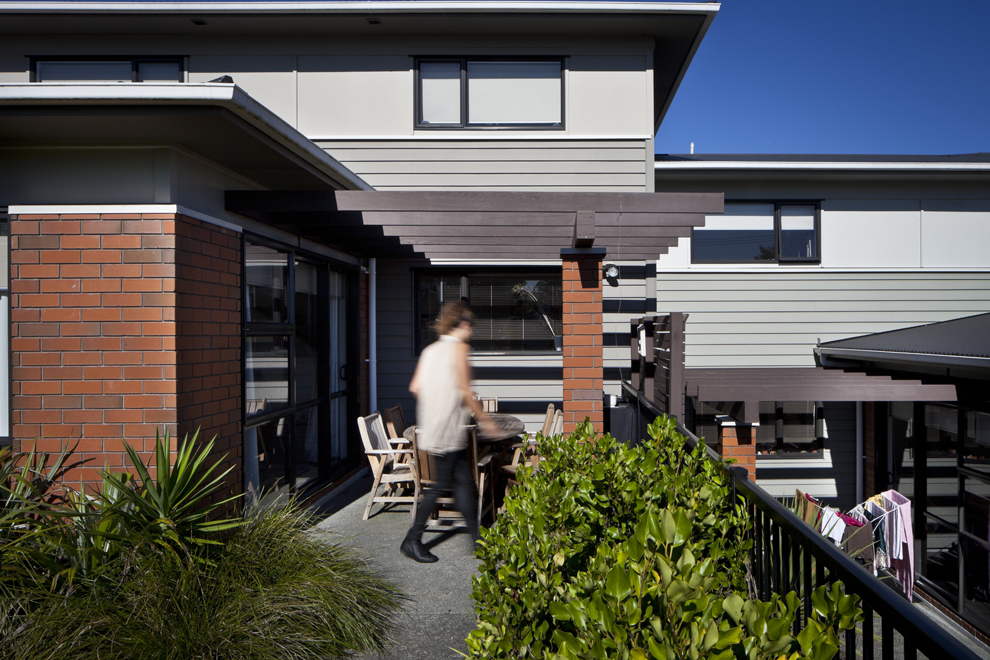 |
| Figure 22: Rooftop patios provide a unique private outdoor space, and should include parapets with railings (3.1.4 f). |
Design intent: To ensure the provision of adequate servicing, vehicle access, and parking while minimizing adverse impacts on the comfort, safety, and attractiveness of streets, sidewalks, and open spaces.
Guidelines
In addition to the strategies outlined in the General Residential and Mixed Use Guidelines:
- Provide landscaping in strategic locations throughout to frame building entrances, soften edges, screen parking garages, and break up long facades (See Figure 23).
Site Servicing
- Exceptions for locating waste collection out of public view can be made for well-designed waste collection systems such as Molok bins.
Parking
- Rear-access garage or integrated tuck under parking is preferred in townhouses, in general, and is required for townhouses facing public streets (See Figure 23).
- Centralized parking areas that eliminate the need to integrate parking into individual units are supported.
- Front garages and driveway parking are acceptable in townhouses facing internal strata roads, with the following considerations:
- Architecturally integrate the parking into the building and provide weather protection to building entries; and
- Design garage doors to limit visual impact, using strategies such as recessing the garage from the rest of the facade.
- Provide visitor parking in accessible locations throughout the site and provide pedestrian connections from visitor parking to townhouse units. Acceptable locations include:
- Distributed through the site adjacent to townhouse blocks; and
- Centralized parking, including integration with shared outdoor amenity space.
Access
- Ensure that internal circulation for vehicles is designed to accommodate necessary turning radii and provides for logical and safe access and egress.
- For large townhouse projects (e.g., master planned communities with internal circulation pattern), a minimum of two access/egress points to the site is desired.
- Locate access points to minimize impact of headlights on building interiors.
- Design the internal circulation pattern and pedestrian and open space network to be integrated with and connected to the existing and planned public street and open space network.
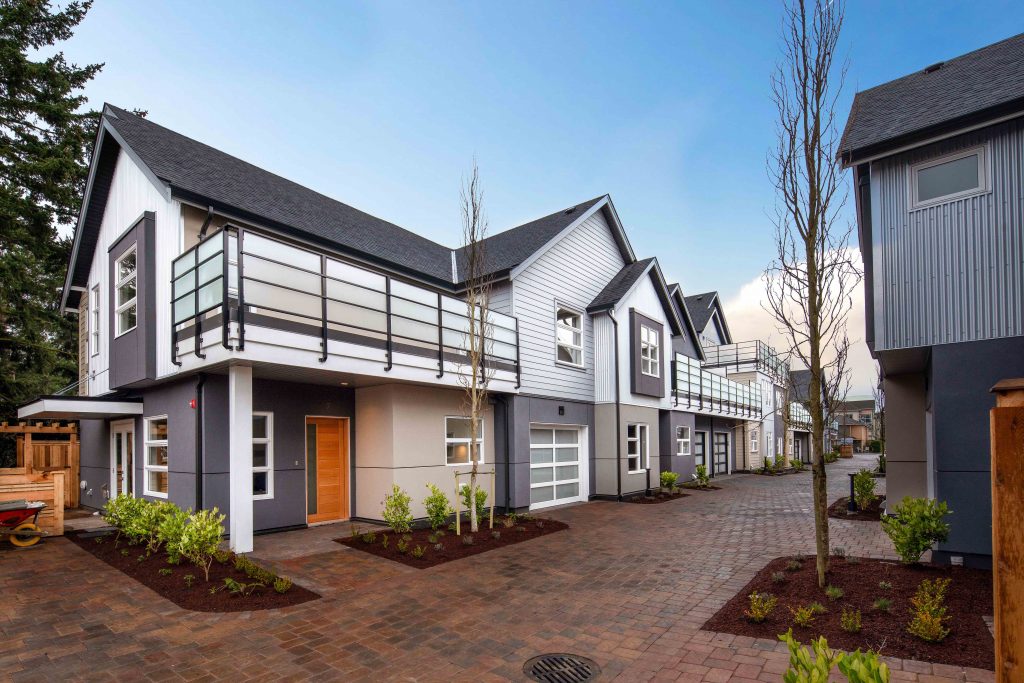 |
| Figure 23: Example of internal roadway designed with high quality pavement materials and strategic landscaping placement (3.1.5 a). |
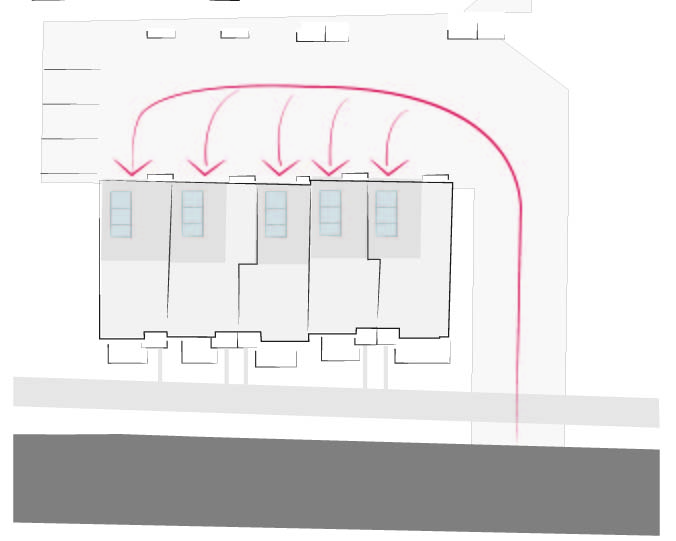 |
| Figure 24: Rear-access parking is preferred in townhouses, in general, and is required for those facing public streets (3.1.5 c) |
Design intent: To enhance liveability, visual interest, and sense of place through building form, architectural composition, and materials.
Guidelines
In addition to the strategies outlined in the General Residential and Mixed Use Guidelines:
- Design facades to articulate the individual units while reflecting positive attributes of neighbourhood character. Strategies for achieving this include (See Figure 25 & 26):
- Recessing or projecting facades to highlight the identity of individual units; and
- Using entrance features, roofline features, or other architectural elements.
- To maximize integration with the existing neighbourhood, design infill townhouses to:
- Incorporate design elements, proportions, and other characteristics found within the neighbourhood; and
- Use durable, quality materials similar or complementary to those found within the neighbourhood.
- Maintain privacy of units on site and on adjacent properties by minimizing overlook and direct sight lines from the building using strategies such as:
- Off-setting the location of windows in facing walls and locating doors and patios to minimize privacy concerns from direct sight lines;
- Use of clerestory windows;
- Use of landscaping or screening; and
- Use of setbacks and articulation of the building.
- In larger townhouse developments (e.g., master planned communities with internal circulation pattern), provide modest variation between different blocks of townhouse units, such as change in color, materiality, building and roof form.
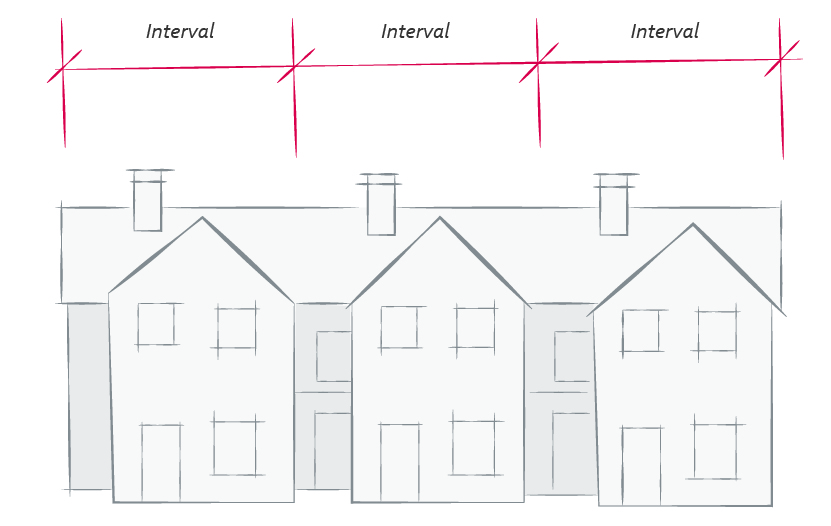 |
| Figure 25: Breaking up a building’s facade into a series of intervals creates a more pleasing human scale expression (3.1.6 a). |
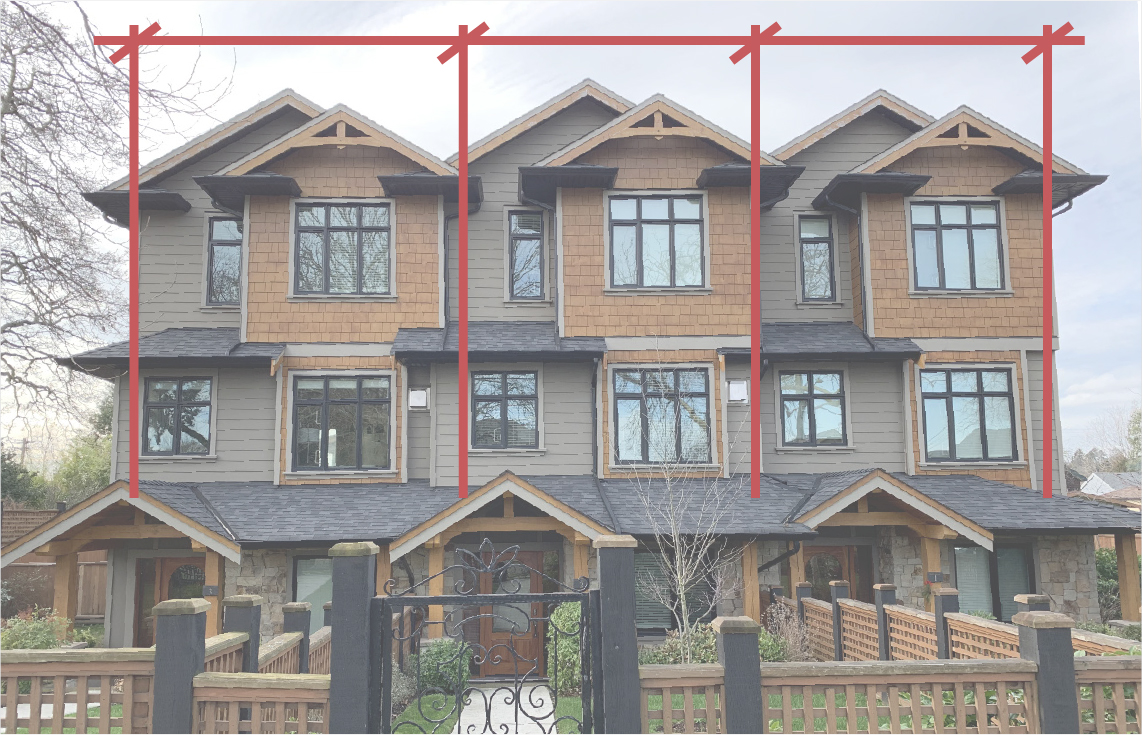 |
| Figure 26: Example of facades and entrance features designed to articulate individual units (3.1.6 a). |
3.2 Infill
Overview |
|
General Characteristics |
|
In order to achieve the design goals of the City, all townhouse projects must:
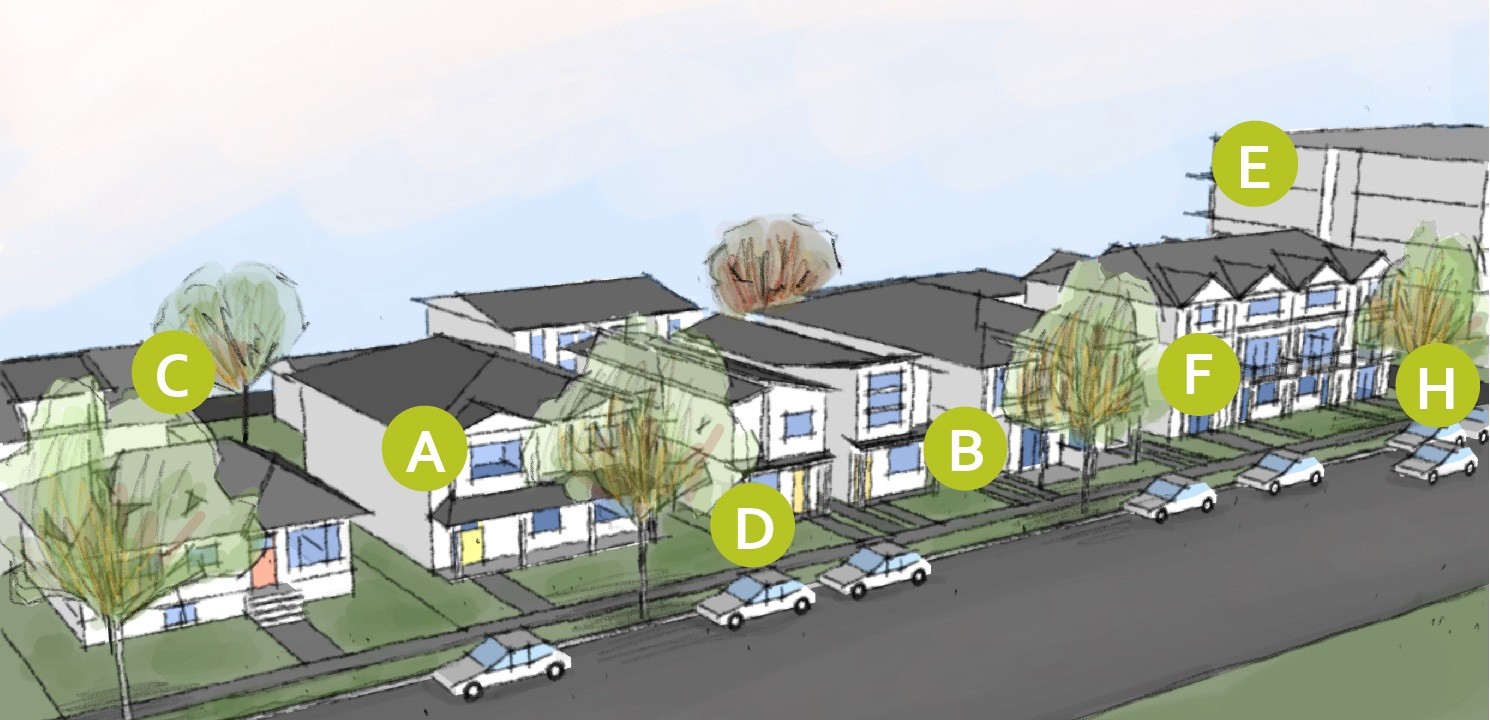
| A | 3.2.1 a - Configure building massing to reflect the general scale of buildings in the surrounding area (see 3.3.2). |
| B | 3.2.1 b - For each unit, provide well-designed, generous outdoor amenity spaces at grade that offer privacy and screening, as well as attractive interfaces with the street and open spaces (see 3.3.1). |
| C | 3.2.1 c - Locate and design buildings to protect existing mature trees on-site (see 3.3.4). |
| D | 3.2.1 d - Limit impermeable surfaces in landscaped areas and open spaces to maximize stormwater infiltration. |
| E | 3.2.1 e - Use building articulation, scaling, and setbacks to define individual units in a way that is clearly oriented to pedestrians rather than to vehicles and that emphasizes connection to the street (see 3.3.1). |
| F | 3.2.1 f - Orient building entries, windows, patios and balconies to face the fronting and flanking streets, with primary entries clearly visible and directly accessible from the sidewalk see (3.3.1). |
| G | 3.2.1 g - Building design elements, details and materials should create a well-proportioned and cohesive building design and exhibit an overall architectural concept (see 3.3.6). |
| H | 3.2.1 h - Provide access to parking from a flanking street or lane, where available. |
Design intent: To site and design buildings to support a positive relationship to the street and public open spaces, while providing a clearly-defined public-private transition zone.
Guidelines
In addition to the strategies outlined in the General Residential and Mixed Use Guidelines:
- Orient the primary façade of buildings to face the fronting street. In the case of lots with multiple frontages, buildings must also be oriented and designed to address flanking streets through architectural and landscape treatments including, but not limited to, front doors and windows (See Figure 27).
- Configure buildings so that a minimum of 50% of units facing streets. All units facing streets should have entries oriented towards, and be clearly accessible and visible from the street.
- Design primary unit entrances to provide:
- A clearly visible front door directly accessible from a public street or publicly accessible pathway via a walkway, porch and/or stoop (See Figure 28);
- Architectural entrance features such as stoops, porches, shared landings, patios, recessed entries, and canopies; and
- Punctuation, articulation and rhythm along the street.
- Use low fencing, landscaping and modest (max. of 0.6m) changes in grade to define a sense of transition from the public to the private realm (See Figure 28).
- Improve the “lanescape” by orienting units located towards the rear of the property to face laneways, and use building entrances, lighting, landscaping and materials to reinforce a safe and attractive public realm.
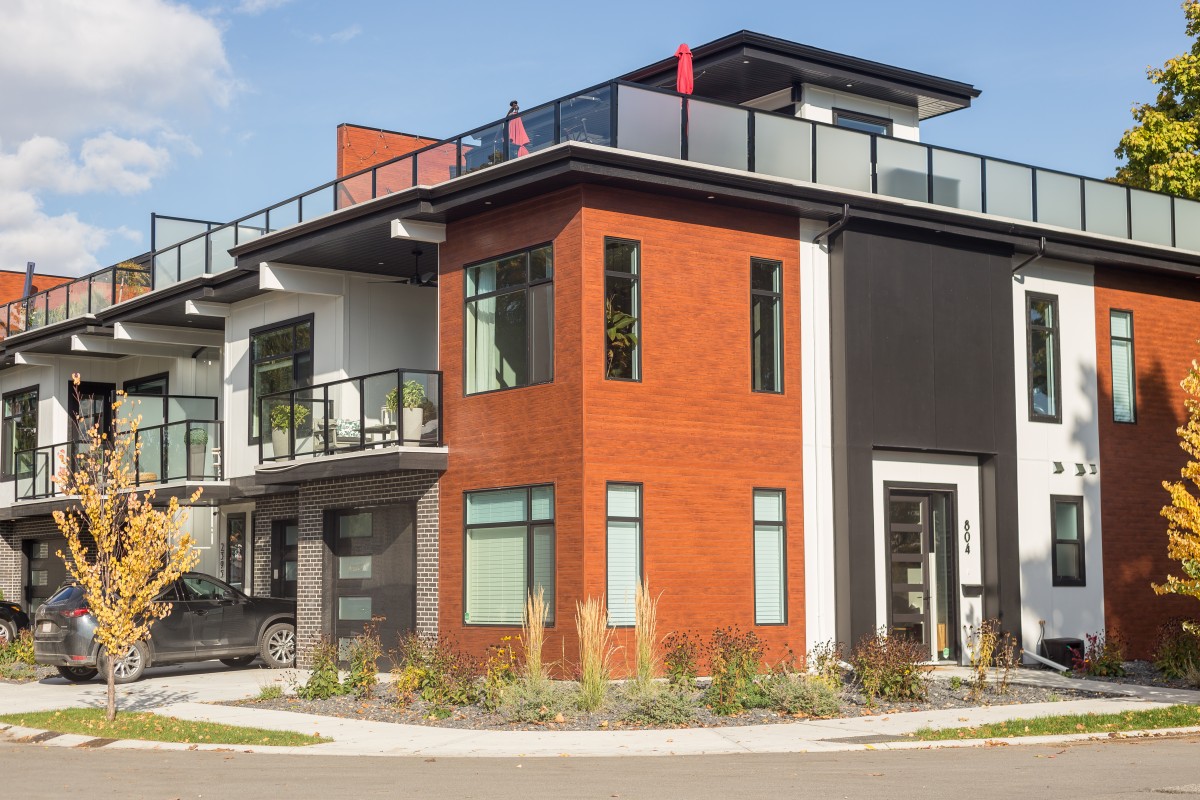 |
| Figure 27: In the case of lots with multiple frontages, buildings must also be oriented and designed to address flanking streets (3.3.1 a). |
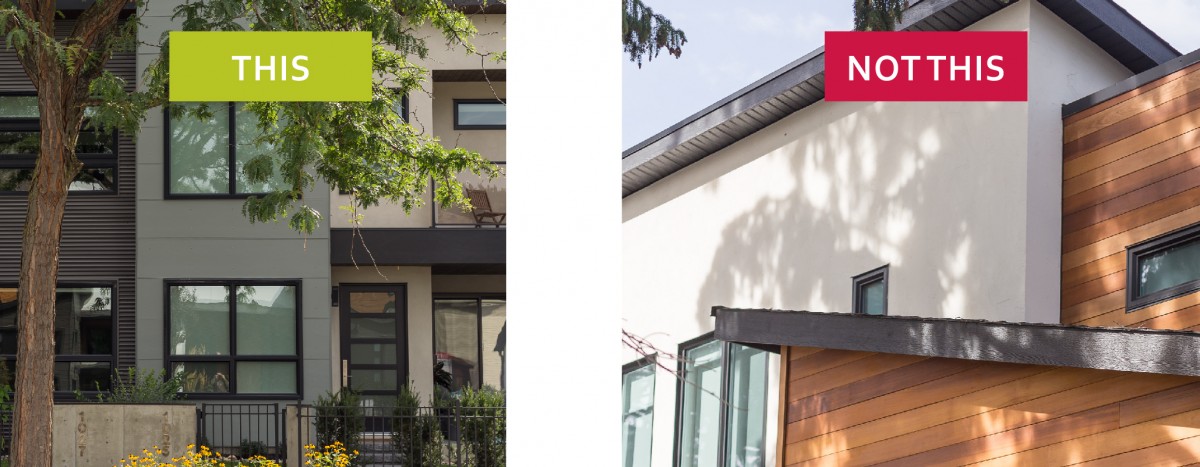 |
| Figure 28: Front doors should be directly accessible via a walkway, porch and/or stoop, and front yards should incorporate complementary landscaping and modest fencing (3.3.1. c, d). |
Design Intent: To ensure that buildings contribute positively to the neighbourhood context while providing opportunity for greater housing choice and diverse building forms.
Guidelines
In addition to the strategies outlined in the General Residential & Mixed Use Guidelines:
- Wherever possible, reflect the positive attributes of adjacent housing (e.g.: rooflines, front porches, entrance features) while integrating new, higher density housing forms.
- Use building height, scale and setbacks to reinforce a generally consistent street rhythm. Limit significant real or perceived height difference (i.e.: more that 1.5 storey difference) between new and existing development in the surrounding area (See Figure 29).
- Ensure that larger buildings break down their massing to reflect the scale of surrounding buildings by using sub-forms and façade articulation (See Figure 20).
- In buildings with more than one unit, articulate individual units through integration of recessed entries, balconies, materials and projection/recess in the façade. Avoid symmetrical units (See Figure 30).
- On sites with more than one building, ensure that buildings are distinct, but designed to achieve cohesive scale, massing and proportion
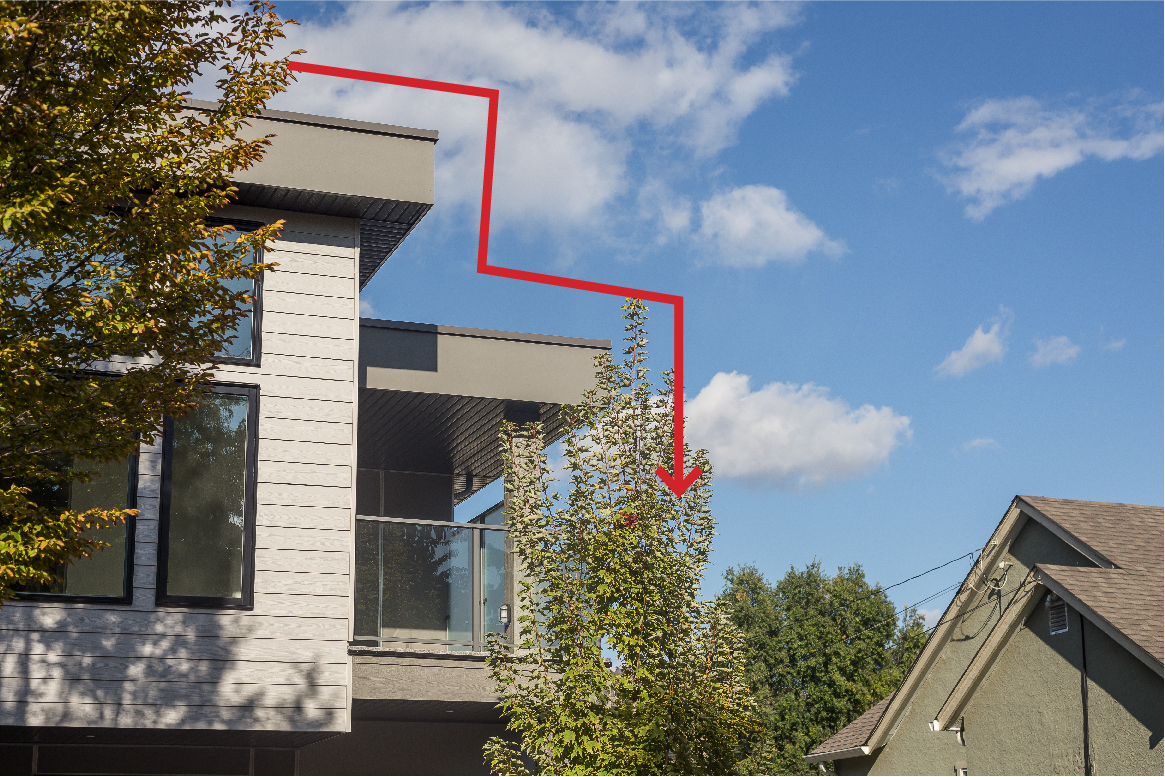 |
| Figure 29: Use building height, scale and setbacks to limit height differences between new and existing development in the surrounding area (3.3.2 b). |
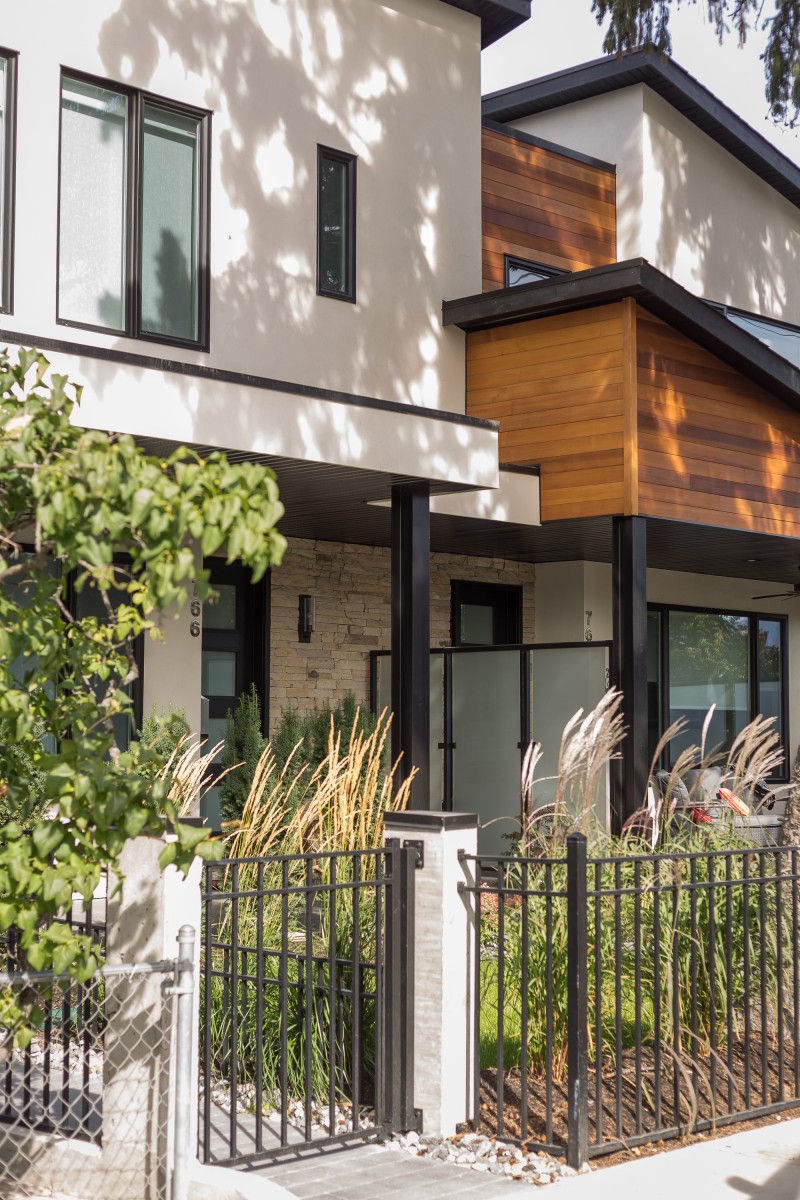 |
| Figure 30: Break down the massing of large buildings through articulation of individual units and avoid symmetry (3.3.2 c, d). |
Design Intent: To site buildings to enhance liveability, privacy, safety, and accessibility; to increase connectivity to surrounding public spaces; and to contribute towards a healthy urban forest.
Guidelines
In addition to the strategies outlined in the General Residential & Mixed Use Guidelines:
- Locate buildings on a site to:
- Protect mature trees, where possible;
- Maintain general consistency with established setbacks on primary and secondary streets, where possible;
- Maximize sunlight access to interior spaces and to outdoor amenity areas; and
- Avoid any required storm drainage infrastructure, such as rock pits.
- Provide pedestrian pathways on site to connect:
- Main unit entrances to public sidewalks and open spaces (minimum width of 1.2m, lit);
- Parking areas to unit entrances;
- From the site to adjacent pedestrian/trail/cycling networks, where applicable; and
- The common utility and water servicing location (See Figure 31).
- Where multiple buildings are located on a site, ensure that outdoor amenity space provided at grade between the buildings is generous and comfortable.
- Maintain privacy of units on site and on adjacent properties by minimizing overlook and direct sight lines from the building using strategies such as:
- Off-setting the location of windows in facing walls and locating doors and patios to minimize privacy concerns from direct sight lines;
- Use of clerestory windows;
- Use of landscaping or screening; and
- Use of setbacks and articulation of the building.
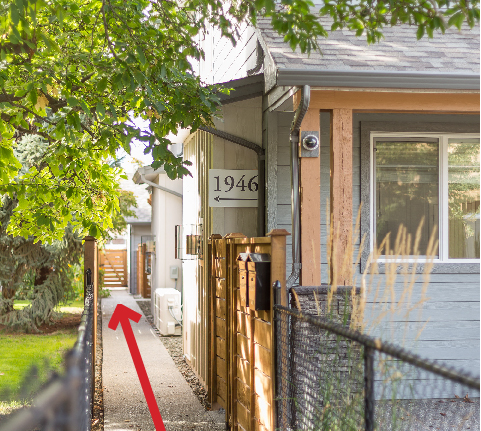 |
| Figure 31: Provide pedestrian pathways on site to connect sidewalks, open spaces, unit entrances, and parking areas (3.3.3 b). |
Design Intent: To design landscapes and open spaces that enhance neighbourhood character, that provide high-quality outdoor living spaces that are useable year-round, and that provide a clear transition between the private and public realm.
Guidelines
In addition to the strategies outlined in the General Residential and Mixed Use Guidelines:
- Design all units to have easy and direct access to high-quality, private outdoor amenity space located at grade that are useable year-round.
- Provide landscaping in strategic locations throughout to frame building entrances, soften edges, screen parking garages/areas, and break up long facades (See Figure 32).
- Design open spaces and landscaped areas to protect and to feature mature trees on site, where possible. Where mature trees cannot be protected or where there were no mature trees on site, ensure that adequate open spaces are provided that will allow shade trees to reach mature sizes.
- Design private outdoor amenity spaces to:
- Have access to sunlight;
- Offer privacy; and
- Have landscaped areas to soften the interface with the street or open spaces (See Figure 33).
- Design front patios to:
- Provide an entrance to the unit; and
- Create a semi-private transition zone using landscape plantings or material changes, or modest (max. 0.6m) grade changes (See Figure 33).
- Design rooftop patios to:
- Minimize direct sight lines into nearby units;
- Have access away from primary facades;
- Have parapets with railings; and
- Minimize the impact of rooftop accesses on the overall height and massing of a building.
- Maximize the use of permeable surfaces in all landscaped and open spaces. Discourage the use of impermeable surfaces, such as poured-in-place concrete.
- Design outdoor amenity areas so that they are not impacted by parking, mechanical equipment or servicing areas.
- Design balconies to be inset or partially inset to offer privacy and shelter, reduce building bulk, and minimize shadowing.
- Design internal driveways to serve as additional shared space using strategies such as:
- High-quality, permeable pavement materials (e.g.: interlocking, permeable pavers);
- Providing useable spaces for sitting, gathering and playing; and
- Providing landscaping that frames and defines pedestrian entrances and soften edges between buildings and hardscapes (See Figure 36).
- Encourage low (1.06m maximum), semi-transparent fencing or railings in the front yard to define the transition between public and private realms. Discourage tall hedges, opaque or tall fencing in the front yard which would limit public interface.
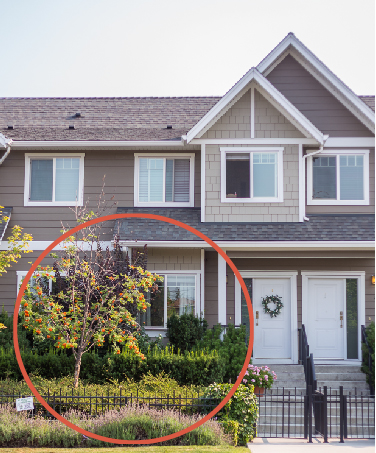 |
| Figure 32: Provide landscaping that frames building entrances, softens edges, screens parking, and breaks up long facades (3.3.4 b). |
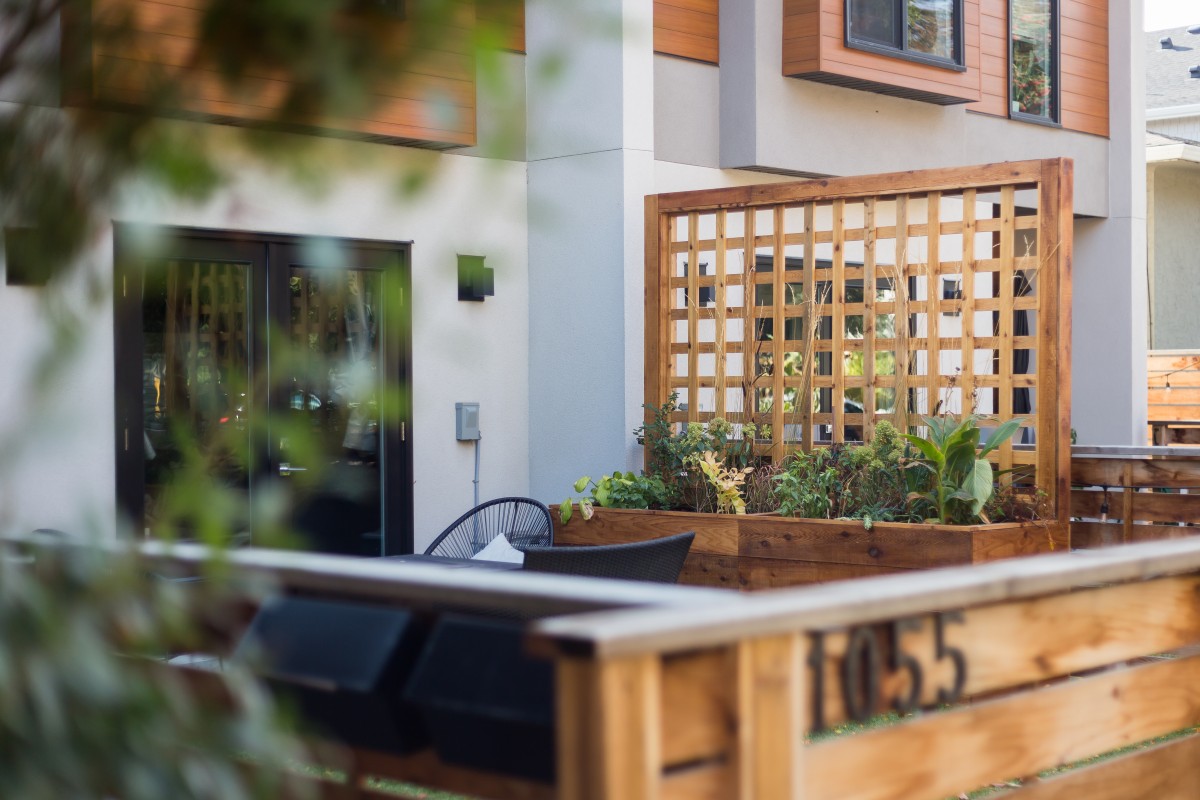 |
| Figure 33: Provide usable outdoor, landscaped amenity spaces that create a transition zone from the street to private residential units (3.3.4 d, e). |
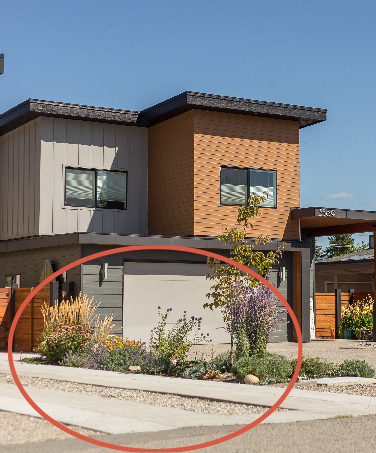 |
| Figure 34: Use permeable paving techniques for driveway areas, and soften paved areas by providing landscaping (3.3.4 j). |
Design Intent: To ensure the provision of adequate servicing, vehicle access, and parking while minimizing adverse impacts on the comfort, safety and attractiveness of streets, sidewalks, and open spaces.
Guidelines
In addition to the strategies outlined in the General Residential and Mixed Use Guidelines:
- Ensure that site layouts include provision for solid waste pick-up and bin storage that is enclosed or otherwise screened from view (See Figure 35).
- Locate mechanical equipment and site services, such as transformers and mailboxes, to minimize impacts on outdoor amenity areas through appropriate siting and screening.
- Ensure that all vehicle parking access is taken from the lane or secondary street, where available.
- Locate parking directly adjacent to street/lane access points to reduce or eliminate driveways, where possible.
- Support common parking areas or garages that eliminate the need to integrate parking into individual units. Where parking is not contained within a garage, ensure it is appropriately screened.
- Where vehicle access is only available via the primary street, ensure that vehicle parking is enclosed and integrated into one or more principal buildings on the site. Limit the visual impact of enclosed parking by using strategies such as recessing the garage from the rest of the façade.
- Ensure that internal circulation for vehicles is designed to accommodate necessary turning radii and provides for logical and safe access and egress.
- Locate access points and windows to minimize impact of headlights on building interiors.
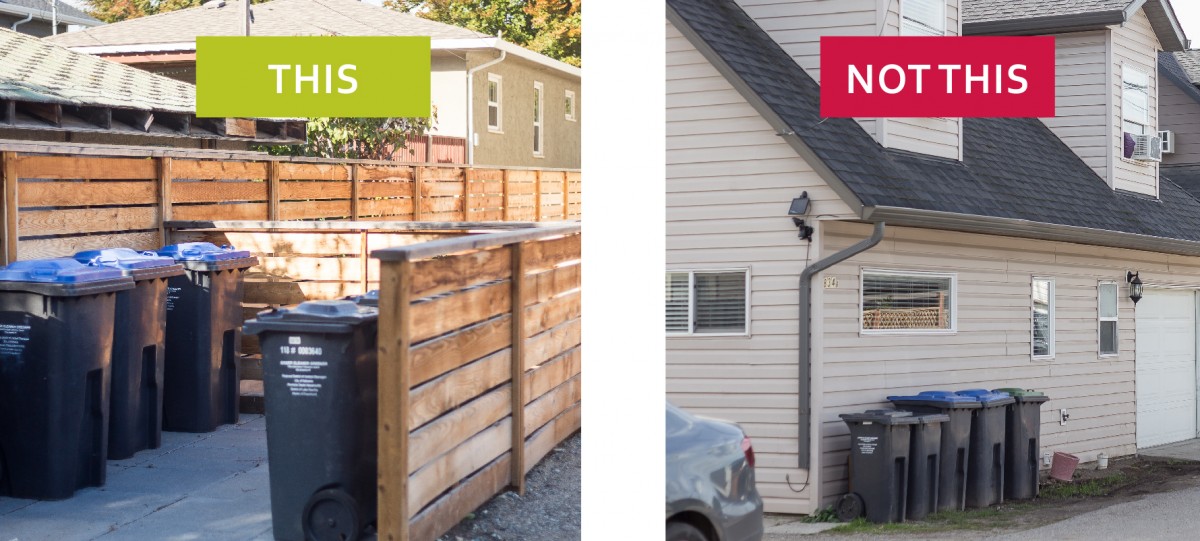 |
| Figure 35: Ensure that site layouts include provision for solid waste pick-up and bin storage that is enclosed or otherwise screened from view (3.3.5. b). |
Design Intent: To enhance liveability, neighbourhood character, visual interest and sense of place through building form, architectural composition, and materials.
Guidelines
In addition to the strategies outlined in the General Residential and Mixed Use Guidelines:
- Design facades to articulate and differentiate the individual units (See Figure 37). Strategies for achieving this include:
- Recessing or projecting facades to highlight the identity of individual units; and
- Using entrance features, roofline features, or other architectural elements.
- To maximize integration with the existing neighbourhood, design infill houses to:
- Incorporate design elements, proportions, and other characteristics found within the neighbourhood; and
- Use durable, quality materials similar or complementary to those found within the neighbourhood (See Figure 26).
- Avoid blank walls by incorporating windows, and articulating the façade with recesses or projections, reinforced by building material changes and landscaping.
- Use increased ground floor height, entryway features, generous glazing, front porches and other architectural features to emphasize the ground floor as the highest design priority.
- On sites with multiple buildings, ensure that each building is unique, but tied together with the same architectural style and material palette.
- Use durable, low-maintenance materials that withstand the local climate (e.g.: wood, natural stone, masonry, metal panels, fibre cement siding, or approved alternatives). Vinyl siding and imitation stone/rock are discouraged and should generally be avoided.
- Use warm, textured materials (e.g.: wood, masonry, stone) to provide contrast and to emphasize focal points (e.g.: entryways), particularly at grade (See Figure 28).
- A maximum of two cladding materials are recommended (See Figure 38).
- Changes in materials should incorporate appropriate trim and detailing and occur at significant changes in plane, including floor level changes and step backs.
- Infill designs should not be repetitive in nature and variation between properties is encouraged.
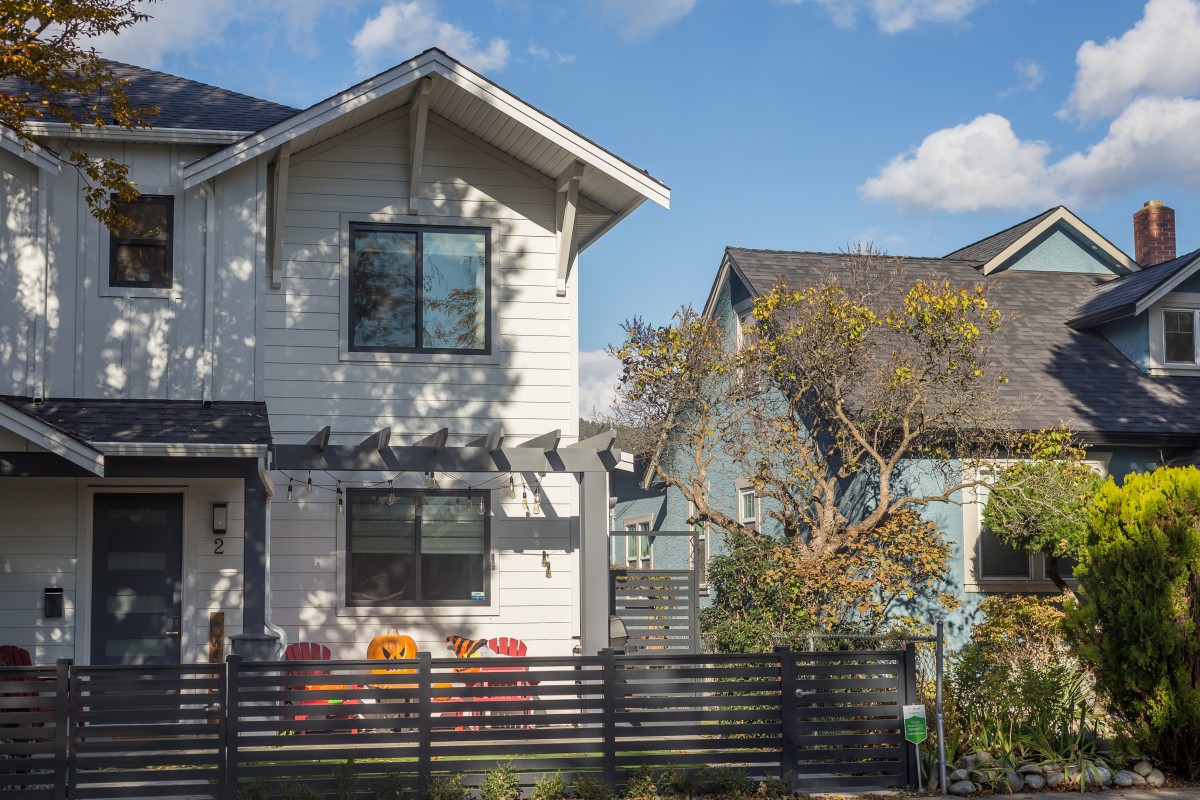 |
| Figure 36: Incorporate design elements, propotions, and materials found in the existing neighbourhood (3.3.6 b). |
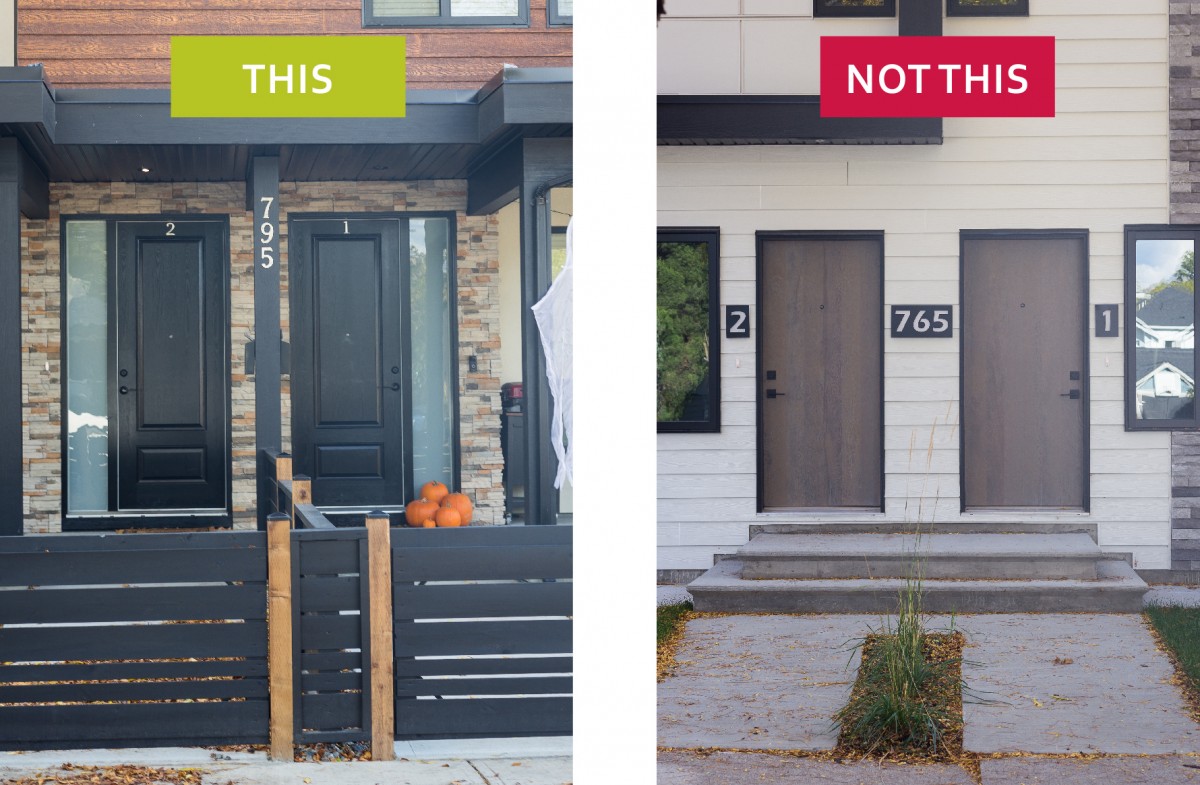 |
| Figure 37: Design facades to articulate individual units using entrance features, roofline features, and other architectural elements (3.3.6a). |
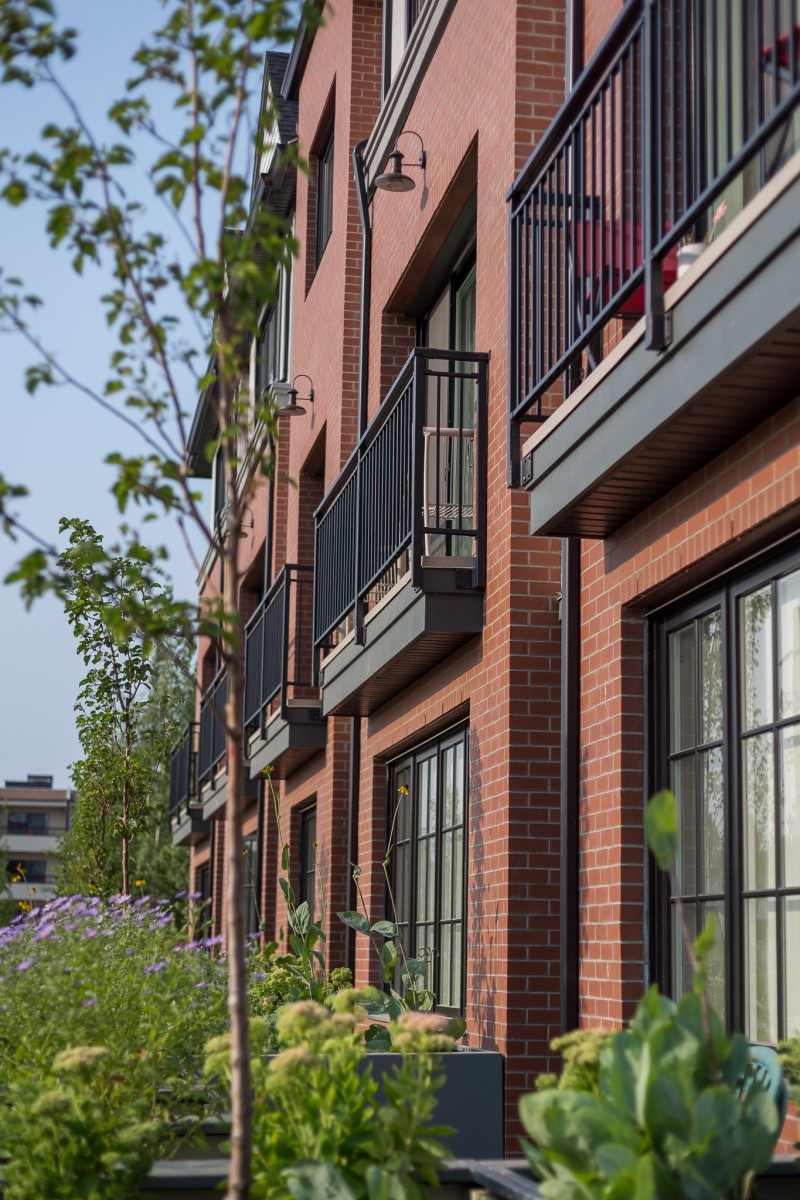 |
| Figure 38: Use up to two warm, textured cladding materials to provide contrast and emphasize focal points (3.3.6 g, h). |
Design Intent: To provide a flexible approach to unit mix and tenure forms in small-scale infill development.
Guidelines
In addition to the strategies outlined in the General Residential and Mixed Use Guidelines:
- Development Permits must be considered in conjunction with the architecture and design of future buildings on the site
- Permissible subdivision configurations include, but are not limited to, those shown in the diagram below.




